Distinctions among GABAA and GABAB responses revealed by calcium channel antagonists, cannabinoids, opioids, and synaptic plasticity in rat hippocampus
- PMID: 18097653
- PMCID: PMC2906116
- DOI: 10.1007/s00213-007-1040-4
Distinctions among GABAA and GABAB responses revealed by calcium channel antagonists, cannabinoids, opioids, and synaptic plasticity in rat hippocampus
Abstract
Rationale: Hippocampal interneurons release gamma-aminobutyric acid (GABA) and produce fast GABA(A)- and slow GABA(B)-inhibitory postsynaptic potentials (IPSPs). The regulation of GABA(B) eIPSPs or the interneurons that produce them are not well understood. In addition, while both micro-opioid receptors (microORs) and cannabinoid CB1R receptors (CB1Rs) are present on hippocampal interneurons, it is not clear how these two systems interact.
Objectives: This study tests the hypotheses that: (1) all interneurons can initiate both GABA(A) and GABA(B) inhibitory postsynaptic potentials; (2) GABA(B) responses are insensitive to mGluR-triggered, endocannabinoid (eCB)-mediated inhibitory long-term depression (iLTD); (3) GABA(B) responses are produced by interneurons that express microOR; and (4) CB1R-dependent and microOR-dependent response interact.
Materials and methods: Pharmacological and electrophysiological approaches were used in acute rat hippocampal slices. High resistance microelectrode recordings were made from pyramidal cells, while interneurons were stimulated extracellularly.
Results: GABA(B) responses were found to be produced by interneurons that release GABA via either presynaptic N-type or P/Q-type calcium channels but that they are insensitive to suppression by eCBs or eCB-mediated iLTD. GABA(B) IPSPs were sensitive to suppression by a microOR agonist, suggesting a major source of GABA(B) responses is the microOR-expressing interneuron population. A small eCB-iLTD (10% eIPSP reduction) persisted in conotoxin. eCB-iLTD was blocked by a microOR agonist in 6/13 slices.
Conclusions: GABA(B) responses cannot be produced by all interneurons. CB1R or microOR agonists will differentially alter the balance of activity in hippocampal circuits. CB1R- and microOR-mediated responses can interact.
Figures
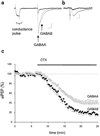
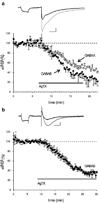
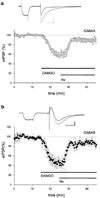

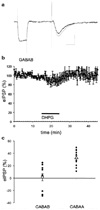

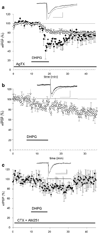

Similar articles
-
GABAB receptor- and metabotropic glutamate receptor-dependent cooperative long-term potentiation of rat hippocampal GABAA synaptic transmission.J Physiol. 2003 Nov 15;553(Pt 1):155-67. doi: 10.1113/jphysiol.2003.049015. Epub 2003 Sep 8. J Physiol. 2003. PMID: 12963794 Free PMC article.
-
Calcium channel involvement in GABAB receptor-mediated inhibition of GABA release in area CA1 of the rat hippocampus.J Neurophysiol. 1995 Jul;74(1):43-53. doi: 10.1152/jn.1995.74.1.43. J Neurophysiol. 1995. PMID: 7472344
-
Cell-type specific GABA synaptic transmission and activity-dependent plasticity in rat hippocampal stratum radiatum interneurons.Eur J Neurosci. 2005 Jul;22(1):179-88. doi: 10.1111/j.1460-9568.2005.04207.x. Eur J Neurosci. 2005. PMID: 16029207
-
Do GABAA and GABAB inhibitory postsynaptic responses originate from distinct interneurons in the hippocampus?Can J Physiol Pharmacol. 1997 May;75(5):520-5. Can J Physiol Pharmacol. 1997. PMID: 9250387 Review.
-
Impairment of Synaptic Plasticity by Cannabis, Δ9-THC, and Synthetic Cannabinoids.Cold Spring Harb Perspect Med. 2021 May 3;11(5):a039743. doi: 10.1101/cshperspect.a039743. Cold Spring Harb Perspect Med. 2021. PMID: 32341064 Free PMC article. Review.
Cited by
-
Glucocorticoid feedback uncovers retrograde opioid signaling at hypothalamic synapses.Nat Neurosci. 2013 May;16(5):596-604. doi: 10.1038/nn.3374. Epub 2013 Apr 7. Nat Neurosci. 2013. PMID: 23563581 Free PMC article.
-
Hippocampal GABAergic Inhibitory Interneurons.Physiol Rev. 2017 Oct 1;97(4):1619-1747. doi: 10.1152/physrev.00007.2017. Physiol Rev. 2017. PMID: 28954853 Free PMC article. Review.
-
Developmental increase in hippocampal endocannabinoid mobilization: role of metabotropic glutamate receptor subtype 5 and phospholipase C.J Neurophysiol. 2014 Nov 15;112(10):2605-15. doi: 10.1152/jn.00111.2014. Epub 2014 Sep 3. J Neurophysiol. 2014. PMID: 25185819 Free PMC article.
-
Shared Mechanisms of GABAergic and Opioidergic Transmission Regulate Corticolimbic Reward Systems and Cognitive Aspects of Motivational Behaviors.Brain Sci. 2023 May 17;13(5):815. doi: 10.3390/brainsci13050815. Brain Sci. 2023. PMID: 37239287 Free PMC article. Review.
-
Ivy and neurogliaform interneurons are a major target of μ-opioid receptor modulation.J Neurosci. 2011 Oct 19;31(42):14861-70. doi: 10.1523/JNEUROSCI.2269-11.2011. J Neurosci. 2011. PMID: 22016519 Free PMC article.
References
-
- Alger BE. Retrograde signaling in the regulation of synaptic transmission: focus on endocannabinoids. Prog Neurobiol. 2002;68:247–286. - PubMed
-
- Andrade R, Malenka RC, Nicoll RA. A G protein couples serotonin and GABAB receptors to the same channels in hippocampus. Science. 1986;234:1261–1265. - PubMed
-
- Bormann J. Electrophysiology of GABAA and GABAB receptor subtypes. Trends Neurosci. 1988;11:112–116. - PubMed
-
- Bowery N. GABAB receptors and their significance in mammalian pharmacology. Trends Pharmacol Sci. 1989;10:401–407. - PubMed
-
- Buzsaki G. Theta oscillations in the hippocampus. Neuron. 2002;33:325–340. - PubMed
Publication types
MeSH terms
Substances
Grants and funding
LinkOut - more resources
Full Text Sources

